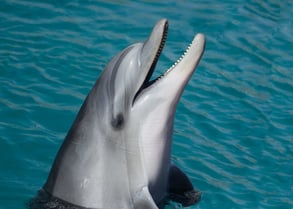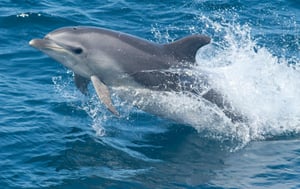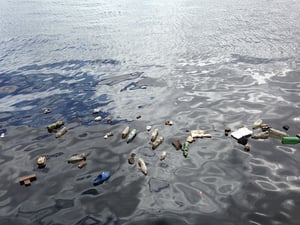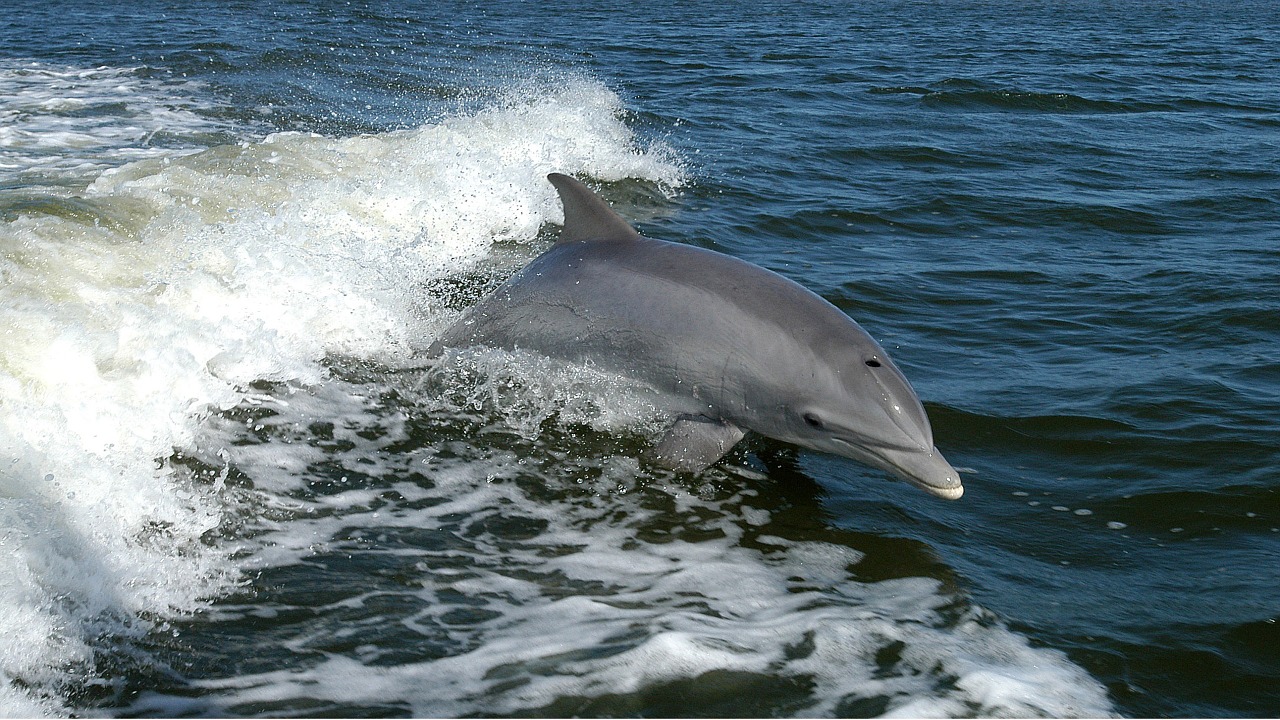Bottlenose dolphins are the most abundant dolphin species inhabiting temperate and warm seas all over the world. Belonging to the genus Tursiops, Bottlenose dolphins can sometimes be confused with the rough-toothed dolphins, Risso's dolphins, and Atlantic spotted dolphins in regions of overlapping distributions.
Physical Appearance and Anatomy
 Bottlenose dolphins are commonly known by their robust coloration that ranges from light gray to black gray with lighter coloration on the belly.
Bottlenose dolphins are commonly known by their robust coloration that ranges from light gray to black gray with lighter coloration on the belly.
- Countershading is suggested to assist with camouflage, concealing them from predators. The darker dorsal side blends in with deeper waters when viewing them from above and the underside blends well with the ocean surface when viewing the animals from below.
- Bottlenose dolphins are streamlined, which significantly reduces drag as they swim. These movements are powered by a very strong muscle called the peduncle (the portion of a cetacean's body between the dorsal fin and the tail), which enables bottlenose dolphins to swim upwards of 15 – 20 mph!
- The average length of adult bottlenose dolphins is between six and 12.5 feet, factors such as their habitat (e.g., prey abundance, water temperature) and sex influence body side. Additionally, their weight ranges from 300 and 1,400 pounds, again, depending on where they live in the world.
Behavior and Diet
In the wild, dolphins eat predominantly fish (piscivorous), but they also consume significant amounts of squid and crustaceans. However, diet varies by region, season, sex, age, and reproductive status. For example, researchers discovered that resident bottlenose dolphins in Sarasota, Florida exhibited a variety of prey in their stomach, but pinfish accounted for approximately 70% of their diet.
Bottlenose dolphins use impressive techniques to pursue and capture prey. This includes things like:
- intentional beaching -where dolphins guide prey up onto muddy shorelines
- fish whacking -where dolphins smack fish clear out of the air with their flukes, often into the mouths of their podmates
- the use of marine sponges as tools to forage for organisms living in the substrate
- “kerplunking” -which involves the creation of a ring (or seine “net”) of bubbles around a school of fish by dolphins driving their flukes through the surface of the water repeatedly
- mud-ring feeding -which is similar to the above but involves the suspension of mud into the water column that presumably startles and corrals fish
Habitats
Bottlenose dolphins are distributed all over the world in both temperate and tropical waters. They occupy a variety of habitats, including nearshore coastal areas (e.g. bays, lagoons, harbors, and river mouths) and deep, offshore waters. In some areas, dolphins exhibit high site fidelity (i.e. a limited home-range), and in others they

are migratory. Two distinct groups of bottlenose dolphins called ecotypes have been identified, and although they are not considered different species, they are characterized by their distribution (nearshore/coastal vs. offshore) and exhibit different physical and physiological characteristics. There is a second species of Tursiops that lives in the Indian Ocean, known as the Indo-Pacific bottlenose dolphins.
Reproduction
Dolphins are mammals and therefore, give birth to live young. The gestation period for bottlenose dolphins is approximately 12 months, and calves are usually born tail first.
At birth, a bottlenose dolphin calf is about 3 – 4 feet long and weighs 30 – 40 pounds. They are born with their dorsal fin flat on their back, and their tail flukes curled. The dorsal fin is usually standing erect by about
24-48 hours after birth, though it may remain wobbly for many years. A newborn calf is generally dark in color with light stripes called fetal folds.
Females begin to reproduce successfully at about 7 – 12 years of age, and males tend to mature even later. Due to a high investment in maternal care, the average inter birth interval in bottlenose dolphins is about 4 – 5 years.
Natural and Human-Caused Threats
Fishing Nets
A threat to marine mammals is entanglement in fishing gear and nets. Many marine mammal species are accidentally caught in nets used by fishermen. This is called “bycatch”, which is the non-target portion of the catch. Passive, or discarded, gear and trash can also cause a significant amount of marine mammal mortality each year. Lost and discarded nets wreak havoc on marine organisms as they drift for many miles and sometimes many years. When a marine mammal gets entangled in a net, they often lose the ability to swim to the surface to breathe and then drown.
Pollution
Marine pollution that you can’t see, specifically toxins, can cause serious health issues in marine mammals. Chemicals such as PCBs, organochlorides, pesticides, and heavy metals are related to reduced immune function (i.e., the ability to ward off infections and disease), an increase in the mortality of newborns, sterility, fewer births, birth defects, skeletal abnormalities, various types of cancer, and neurological dysfunction.

Oil spills suffocate marine environments and cause serious issues for many marine organisms. Marine birds and marine mammals tend to suffer heavily from exposure to oil, because they lose their ability to float and insulate themselves when their feathers/fur become soaked with oil. The long-term effects on marine mammals from oil spills are associated with the ingestion of the oil and the inhalation of hydrocarbon vapors.
Other threats to marine mammals include sound pollution (interferes with communication, breeding, diving, migrating, and feeding), collision with vessels (particularly manatees but also occurs between dolphins and whales and large ships), river regulation devices (causes drowning of manatees and river dolphins), habitat destruction, and climate change (e.g. global warming and the loss of polar bear habitat and prey).









